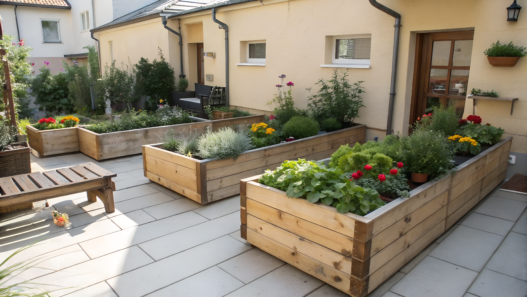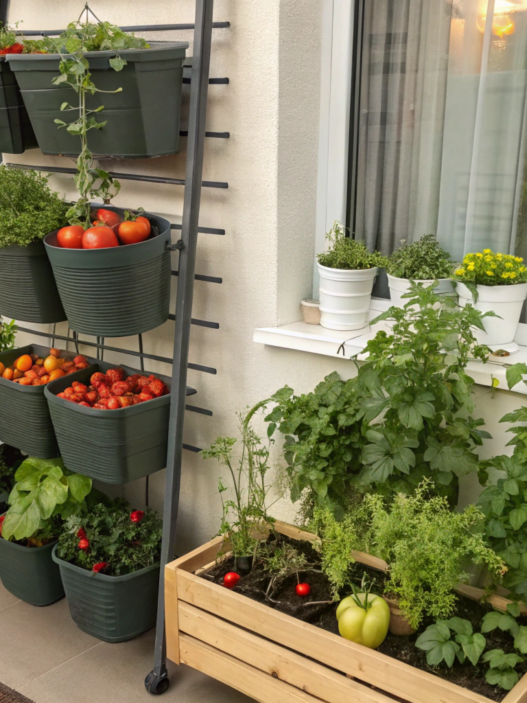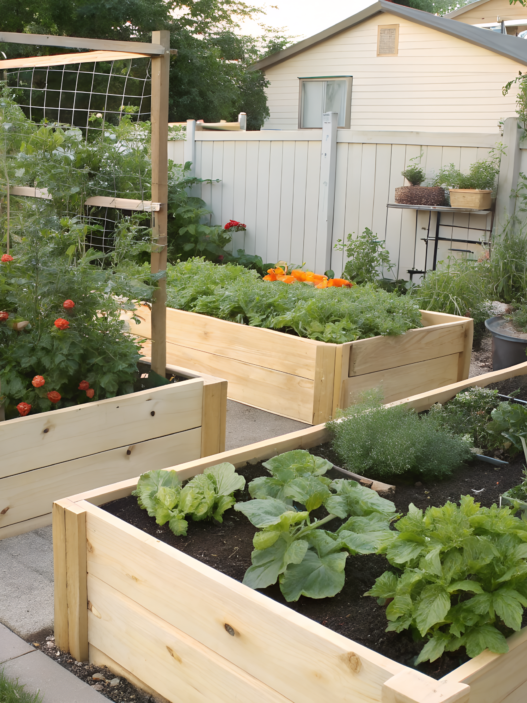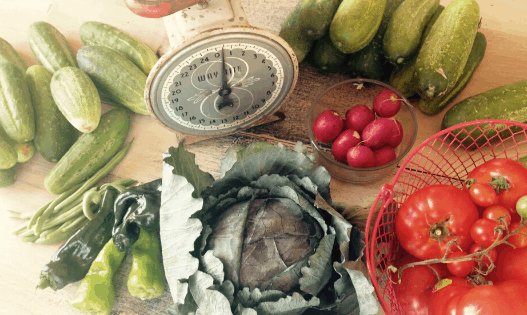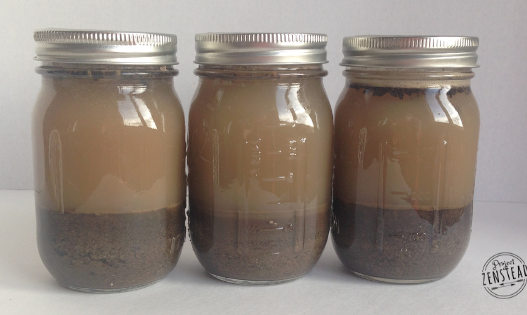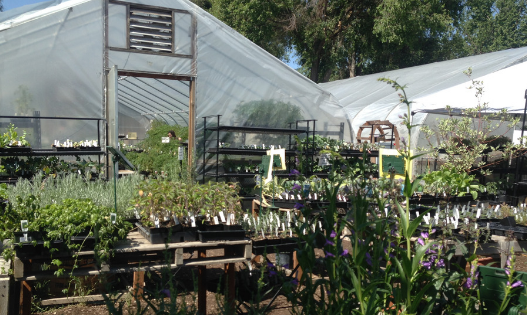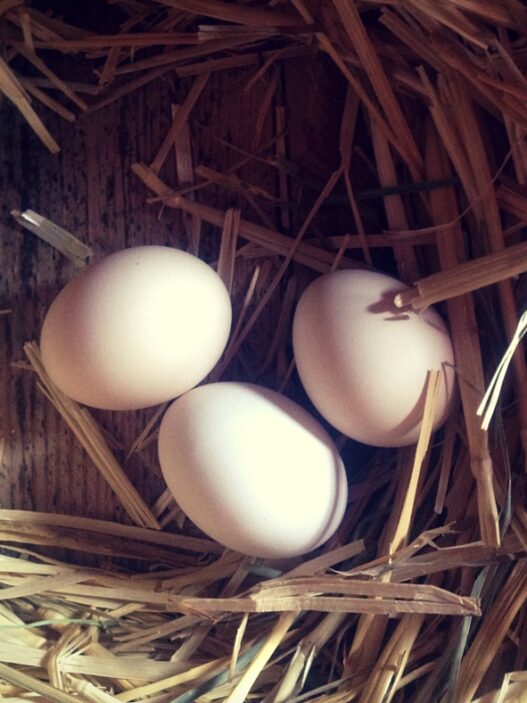Growing plants in tall beds isn’t just a gardening trend, it’s the only option for those with little space. Maybe you have a tiny backyard, balcony or a narrow strip of land along a fence, It doesn’t matter at all. In any case, a properly selected high bed will help to grow a good harvest, while maintaining order and ease of care.
So let’s figure out which beds are best for small spaces and find the perfect one for your garden!
1. Compact Raised Beds for Tiny Yards – Maximize Your Harvest!
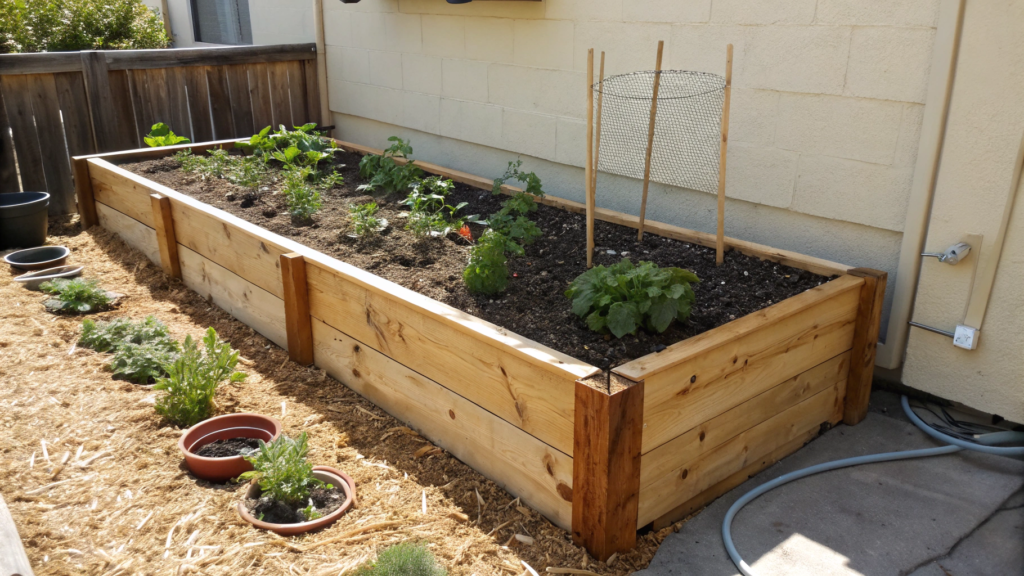
Deep soil beds are the best solution for a small yard. They give more room for roots, save water and maximize your yields. The most important thing here is the depth, not the width of the bed.
How to make a bed for a small yard
- Choose a sunny spot (6+ hours of light). If it’s not enough, place the bed against a lighted wall for extra light.
- Materials. Cedar, galvanized metal or plastic are best, they are durable and easy to maintain.
- Depth – 30cm or more (45+cm for carrots and beets).
Best Choice Products 4x3ft Wooden Raised Garden Bed – compact, roomy and durable.
Drainage and soil
- To avoid water stagnation and root rot, the bed must be properly prepared:
- Drainage layer (5-10 cm): crushed stone, expanded clay or gravel.
- Fertile soil. It is recommended to use a mixture of compost, peat and garden soil in equal proportions.
- Mulching. A layer of straw, hay or wood chips helps retain moisture.
How to save space
For cucumbers, peas, beans, you can use vertical structures, for example, grids. Also saves space square farming, when it is necessary to divide the bed into sections of 30×30 cm and plant different crops in each.
It is not bad to carry out joint planting, just combine plants (tomatoes + basil) to increase yields.
Best plants for compact beds
- Greens: spinach, salads, kale.
- Berries: strawberries – conveniently placed on the edges.
- Herbs: basil, parsley, garlic.
- Root vegetables: carrots, radishes, beets.
Tip. If you use a greenhouse shelter, the bed will work all year round.
2. How to Build Multi-Level Raised Beds for More Growing Space
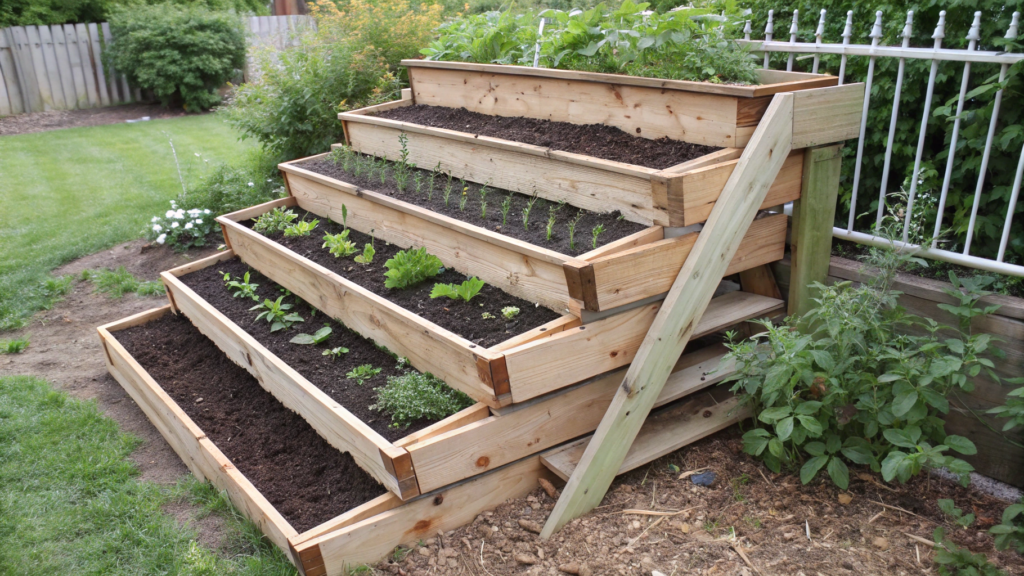
By using multi-level raised beds you can grow more vegetables on the same plot. These beds create more growing space.
In such a bed, each level is higher than the previous one, like the rungs of a ladder. This not only looks neat, but also helps to distribute the plants according to their needs.
What to make a tiered bed out of?
The frame of the bed can be different:
- Wood (cedar, larch) – natural and environmentally friendly, but requires treatment against moisture.
- Metal – a durable option, but in the heat can get very hot.
- Brick or stone – durable materials, but it is more difficult to make such a bed.
To avoid problems with moisture at the bottom of each tier put a drainage layer (expanded clay or crushed stone), and then fill with a nutrient mixture of compost, garden soil and peat.
Distribution of plants by tiers
- Lower tier (deep and moist soil) – carrots, beets, radishes, potatoes.
- Middle tier (optimal conditions for most vegetables) – spinach, onions, peppers, eggplant, salads.
- Upper tier (dry and drained soil) – strawberries, basil, thyme, rosemary.
But it is important to consider not only the tiers, but also the location of plants on each level:
- Curly crops (cucumbers, beans, peas) – it is better to place them on a lattice, so that they do not shade other plants.
- Medium-growing crops (peppers, eggplant) – closer to the center so they get enough light.
- Low-growing plants (herbs, strawberries) – near the front edge to make them easier to care for and harvest.
Tip. Install drip irrigation, this will help evenly moisten all tiers and protect against drying out the upper tiers.
3. Vertical Raised Garden Beds – Grow More in Less Space!
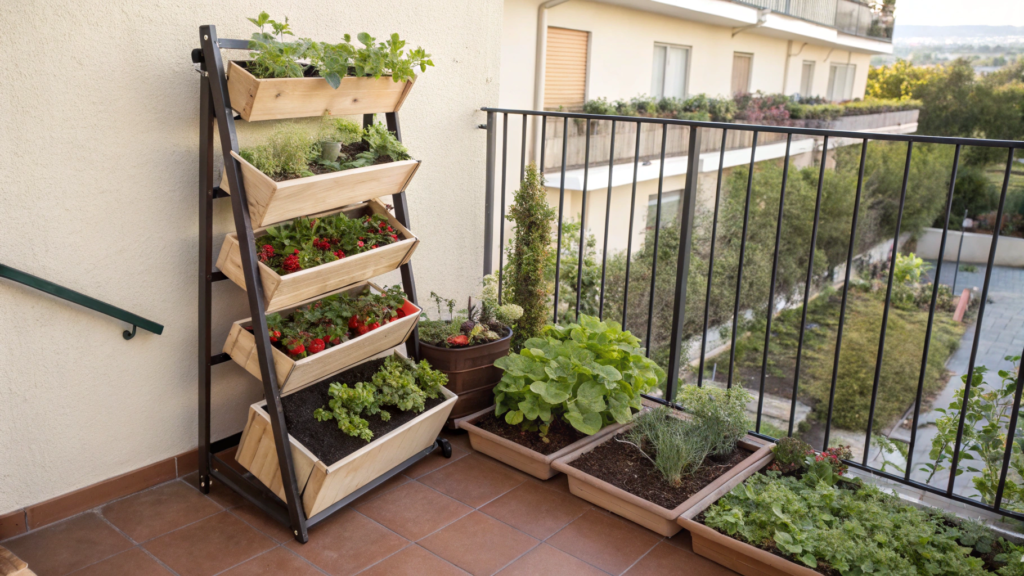
Vertical Raised Garden Beds work as plant beds, allowing you to place salads, herbs, strawberries in tiered containers or hanging planters. It’s perfect for balconies, small yards and patios.
Before you start, it’s worth thinking about where you’ll be putting it and what you want to grow on it. If it’s a balcony, it’s important that the bed doesn’t overwhelm the structure. If in the yard, you can use more massive materials and not be afraid of excess weight.
- Choose a design
- Vertical rack with tiers – a classic option, which is put against the wall or in the corner.
- Suspended fabric pockets – ideal for fences and balcony enclosures.
- Pyramidal bed – looks spectacular, easy to care for plants from all sides.
- Materials for the frame
- Wood – looks beautiful, but needs protection from moisture. Cover it with natural oil or varnish. This way the bed will last longer.
- Metal – strong and durable, but can overheat in the sun.
- Plastic or fabric – lightweight and mobile, but it’s important that the material is weather resistant.
- Fill containers with the right soil
- For herbs and flowers – light, moisture-absorbing soil with compost.
- For vegetables and berries, a nutrient-rich mix with a drainage layer.
- Place plants wisely
Not all crops are suitable for vertical placement. Root crops, pumpkins and zucchini will not take root here. But herbs, strawberries and small vegetables are a great option!
- Top tiers – sun-loving herbs (rosemary, basil, mint).
- Middle tier – salads, greens, strawberries.
- Lower tiers – shade-loving plants (sorrel, spinach).
Tip. Add edible flowers (nasturtiums, calendula). They will decorate the bed and deter pests.
4. Self-Watering Raised Beds – Perfect for Busy Gardeners!
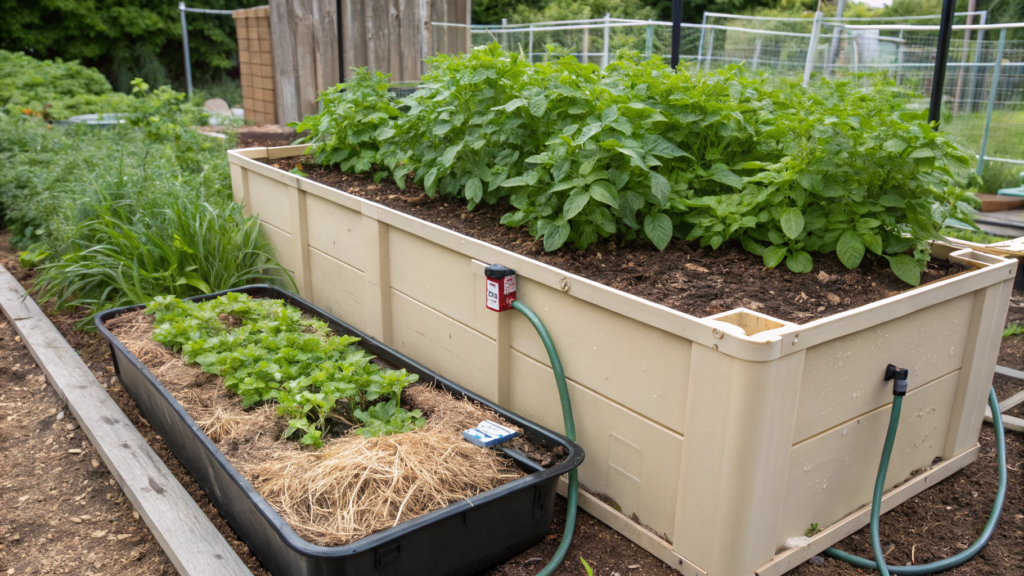
Self-watering raised beds are very convenient, especially for busy gardeners and travelers. The built-in reservoir holds a supply of water, moistening the soil for days without you having to do anything.
How do self-watering beds work?
- A built-in reservoir beneath the soil holds the water.
- A capillary system delivers moisture to the roots.
- A water level indicator tells you when to refill.
How can you improve efficiency?
- Add a drainage layer (expanded clay or gravel). This is good for preventing stagnant water.
- Use mulch (straw, bark). It will slow evaporation and prolong the self-watering effect.
Tip. These beds reduce water consumption by 50%, making them an environmentally friendly solution.
5. Collapsible Raised Beds – A Space-Saving Garden Hack
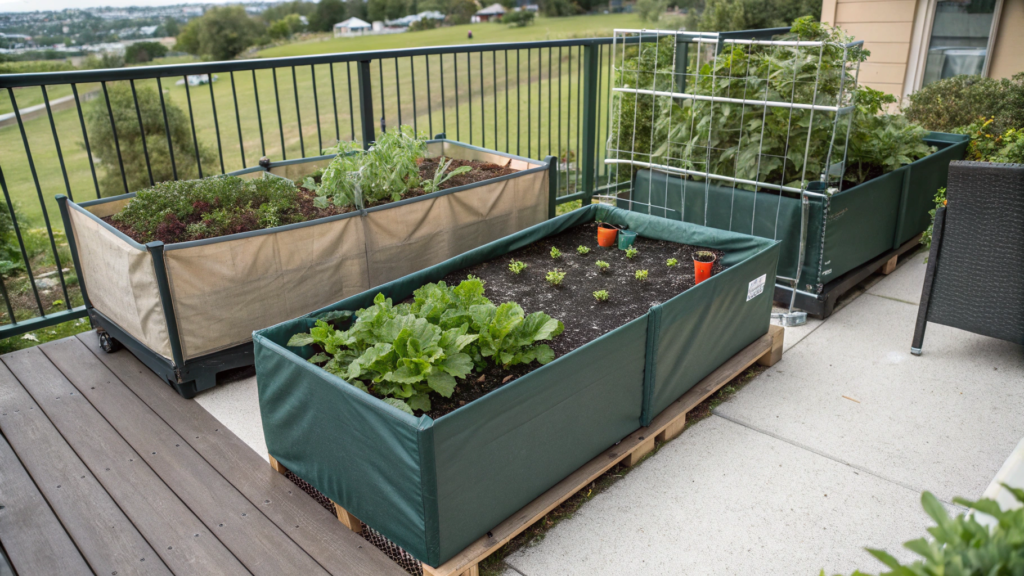
Collapsible raised beds can be set up quickly and then disassembled and put away after the season. They are suitable for rented accommodation, temporary plots, balconies and even for those who like to change the arrangement of plants in the garden.
Such beds come in different types:
- Fabric containers – lightweight, allow air to pass through, prevent roots from overheating.
- Folding metal beds – strong, durable, but require protection from corrosion.
- Composite material beds – weather resistant, but slightly heavier.
Soil and drainage
Since such beds do not have a rigid bottom, it is important to properly prepare the substrate:
- The basis – light, loose soil, for example, a mixture of peat, compost and garden earth.
- Drainage – a layer of expanded clay or gravel at the bottom of the container will improve water drainage.
- Mulching – this will help retain moisture in the soil, especially if the bed is in full sun.
Which plants are best?
Collapsible beds are great for shallow root vegetables and herbs. For example:
- Salads, spinach, parsley, basil – require a small layer of soil, grow quickly.
- Radishes, green onions, dill – compact and do not need deep soil.
- Small strawberry bushes – do well even in fabric containers.
Not suitable: potatoes, corn, large bush plants – they need a deep and stable bed.
Advantages of folding beds:
Easy to assemble and put away – no tools or complicated assembly.
Can be moved – the weight is light, carrying is easy.
Ideal for seasonal gardening – after summer you can disassemble and put away until spring.
Tip. If your budget is limited and you need a temporary bed, try fabric models, they can be folded up and put away at any time.
6. Raised Beds on Wheels – Move Your Garden Anywhere!
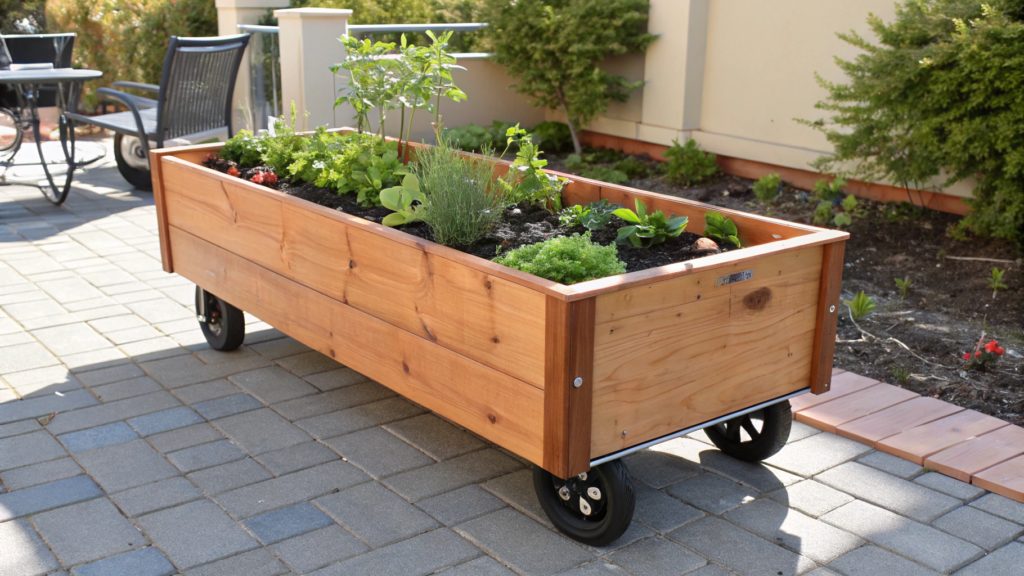
I’m sure you want your plants to get the most sun at all times. With mobile beds, you can roll your garden to where the best light is, and move it under cover during inclement weather. This is a great solution for urban gardens and small yards.
How do you choose the perfect rolling bed on wheels?
- Reliable swivel wheels – for easy movement.
- Depth of 30+ cm – suitable even for vegetables with long roots.
- Drainage holes – prevents stagnant water when moving.
Yaheetech Mobile Raised Garden Bed – stylish, stable and easy to move.
Tip. Use warm tones to color your raised garden bed. Not only is it beautiful, but it helps the soil warm up faster in the spring.
7. How to Set Up a Rooftop Raised Garden – Use Every Inch!
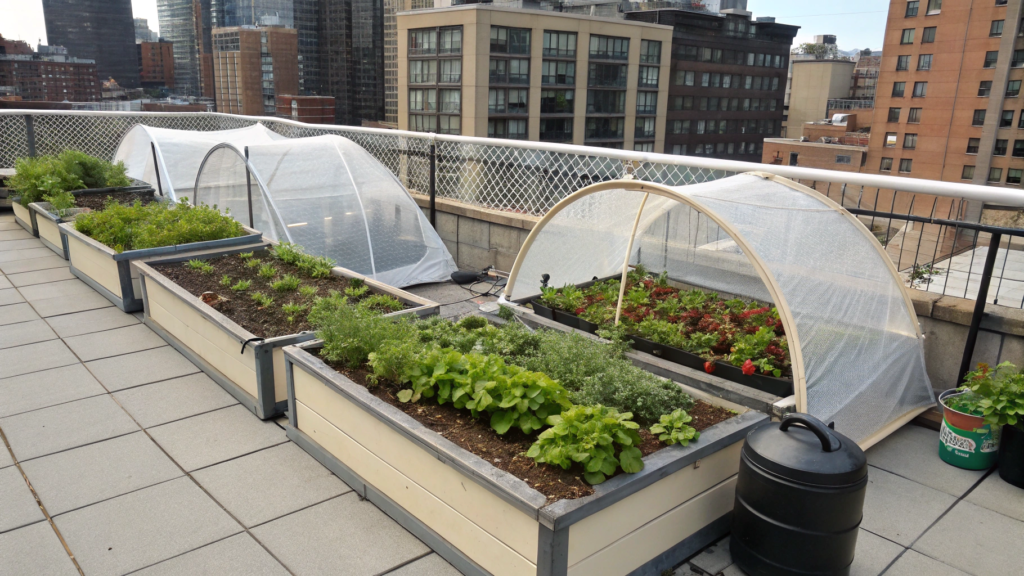
A rooftop or patio is not just a space in the sun, but a great place for a mini vegetable garden. The key is to choose lightweight raised beds that don’t overwhelm the structure and are protected from the wind. Such a garden is ideal for city dwellers who want to grow fresh vegetables, herbs and berries without having their own plot.
The best option is Vegepod Raised Garden Bed with Cover – ideal for windy roofs due to the protective shelter.
How to create raised garden beds on your roof?
- Check the load. Soil and water are very heavy! Make sure the roof can support the weight of the soil and water.
- Use lightweight materials. It’s better to use lightweight beds made of plastic or fabric so you don’t overload the structure.
- Add wind protection. Nets, fences, transparent dividers – will reduce wind gusts without creating excessive shade.
- Choose the right soil. Heavy garden soil is not suitable – it is too dense and makes the beds heavy. Coconut fiber and compost-based mixes reduce weight.
- Use mulch (straw, wood chips, ag fiber). This will reduce water evaporation.
Not all plants are suitable for the roof, because it can be windy, hot and there is little soil. The best choice is unpretentious, weather-resistant crops.
- Greens and herbs – basil, spinach, mint, parsley, thyme, cilantro.
- Compact vegetables – peppers, low-growing tomatoes, radishes, lettuces.
- Berries – strawberries, gooseberries in containers.
- Curly plants – peas, beans (but need a support).
Potatoes, corn, large bush plants are not suitable – they need deep soil.
A rooftop vegetable garden is an opportunity to grow fresh vegetables and herbs even in an urban environment!
Tip. Place self-watering containers to keep plants from drying out in the sun.
8. Smart Raised Beds for Small Yards – These Ideas Really Work!
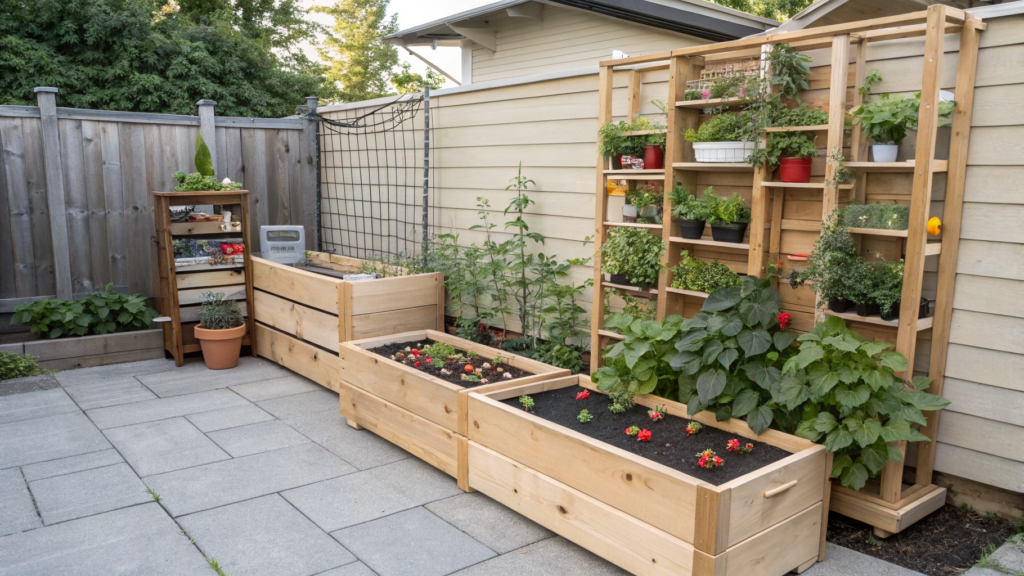
Do conventional beds take up too much space? Modular, tiered and compact designs solve the problem! They help you utilize every corner of your yard by combining vertical gardening and built-in storage.
The Giantex Wooden Raised Garden Bed with Trellis is a wooden bed with trellis that allows you to grow curly vegetables while saving horizontal space.
What kind of smart beds are there?
- With trellis – ideal for climbing plants such as beans, peas and tomatoes.
- With built-in shelves – provide a convenient place to store garden tools and accessories.
- Tiered – allow you to grow a variety of crops in one area, optimizing the use of space.
Tip. Use beds with side drawers to easily change planting heights for different plants.
By using smart beds, you will not only save space, but also create an aesthetically pleasing and productive garden even in a small plot.
9. Mini Raised Beds for Narrow Spaces – Ideal for Urban Gardens!
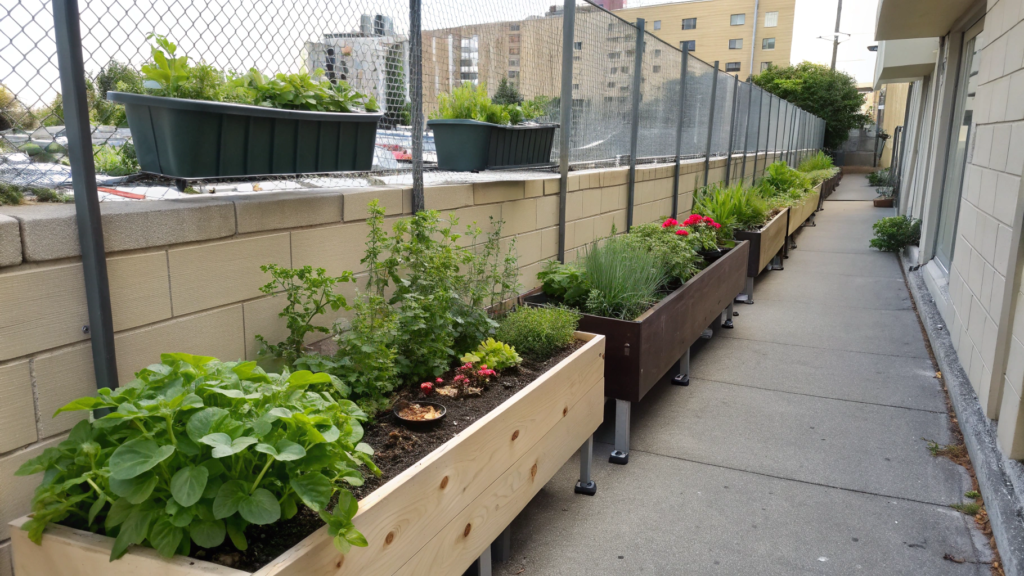
You know, a narrow space along a fence, driveway or wall can also yield crops. Compact mini beds make efficient use of even the most difficult areas, turning them into a productive urban garden.
These beds are convenient not only for growing vegetables and herbs, but also for ornamental plants, creating a green hedge or a corner with spicy herbs.
How to place mini beds in narrow spaces
- Vertical wall containers – suitable for hanging structures on fences, walls and balconies.
- Long narrow beds on legs – do not take up space on the ground, convenient in care, they are easy to maintain.
- Tiered systems – give the opportunity to grow more crops on the same area.
What plants are suitable for mini beds?
Not all crops feel well in narrow spaces, so it is worth choosing compact and unpretentious.
- Herbs and spicy herbs – basil, parsley, mint, thyme, rosemary.
- Root crops – radishes, carrots, beets (if the soil is deep enough).
- Compact vegetables – low-growing tomatoes, sweet peppers, bush cucumbers.
- Berries – strawberries, which grow well in hanging containers.
Use light soil – a mixture of peat, compost and garden soil will provide good drainage.
Tip. Use joint planting – combine plants that help each other (e.g. basil next to tomatoes).
10. Raised Beds with Built-In Seating – Comfort & Functionality!
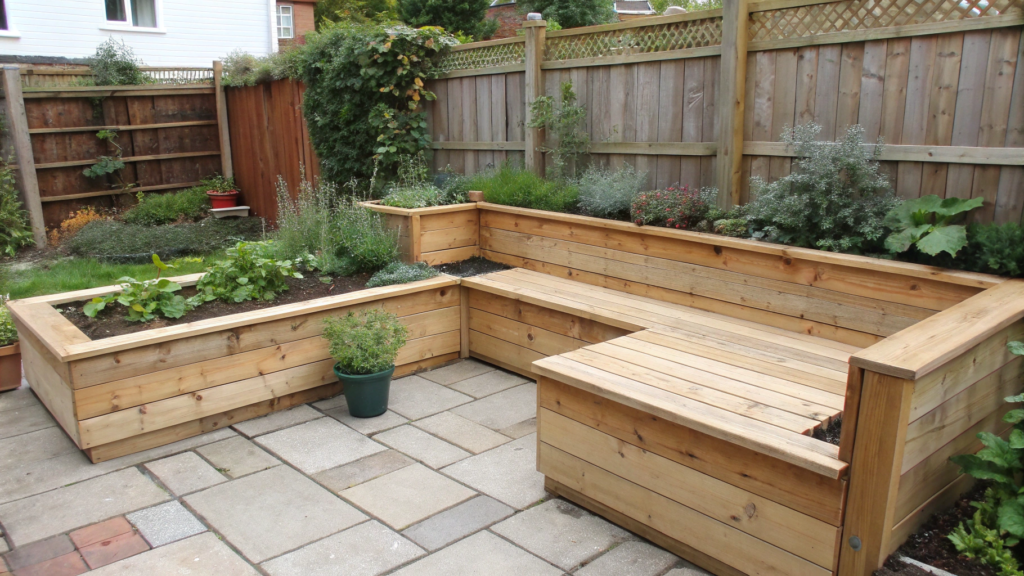
Why choose between comfort and harvest when you can do both? Raised beds with benches are the perfect solution for small yards where every meter counts. You can tend to your plants while sitting in a comfortable position, and then just relax and enjoy the view of your garden.
How to organize a bed with a bench?
If you want not just a bed, but a cozy corner for rest, you can choose one of two options:
- Ready-made structures. They are sold as prefabricated kits that are easy to install.
- Homemade version. If there are basic skills of working with wood, you can make such a bed by yourself.
The main elements:
- Frame – a tall wooden bed made of cedar, pine or oak will do.
- Bench – attached to the sides of the bed, 20-30 cm wide, so that it was comfortable to sit on it.
- Reinforcement of the structure – metal corners give strength and durability.
- Protection from moisture – treat the wood with stain or oil so that it does not rot.
- Additional comfort. Soft cushions or moisture-resistant seats will make the bed even more comfortable.
Tip. If the bed is wide, you can make corner benches to organize a small seating area right in the garden.
11. Slim Raised Beds Along Fences – A Clever Space-Saving Trick
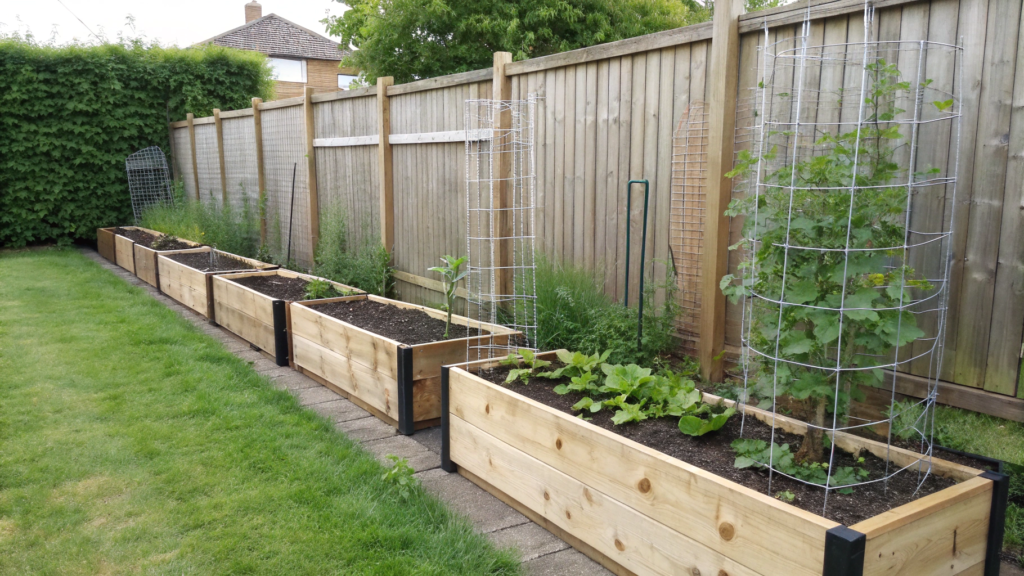
The remaining unused space along a fence can become a fruit-growing area. Tall, narrow beds fit perfectly along fences without taking up too much space, but still provide a harvest even in the smallest of spaces.
Such beds can be placed even where conventional structures will not fit – along the fence, along the wall of the house, between the paths. The main thing is to choose the right plants and properly organize the space.
How to properly organize beds along the fence?
1. Choose the right type of bed. You can use narrow beds made of wood, metal or tiered narrow beds.
2. Create a solid base. The optimal width of the bed – 30-40 cm, so as not to clutter the site. The height of 40-50 cm provides enough space for the roots. The bottom can be left open for natural drainage or covered with geotextile.
3. Think about a support system
- Lattices and trellises can help utilize vertical space for peas, beans, cucumbers.
- Suspended cachepots can be fixed directly on the fence for strawberries and small ornamental plants.
What plants are suitable for narrow beds?
- Curly crops – peas, beans, cucumbers, grapes. They will climb up without taking up space across the width.
- Umbrella vegetables – dill, carrots, parsnips – their narrow leaves do not interfere with neighbors.
- Herbs and spicy herbs such as basil, parsley, mint, thyme – they do well even in narrow containers.
- Berries – strawberries or gooseberries can grow along the fence, especially if you install hanging pots.
Tip. Attach lattice or trellis to tie plants – this will increase yields and create a green wall instead of a bare fence.
12. Raised Beds for Herbs & Greens – Perfect for Small Balconies!
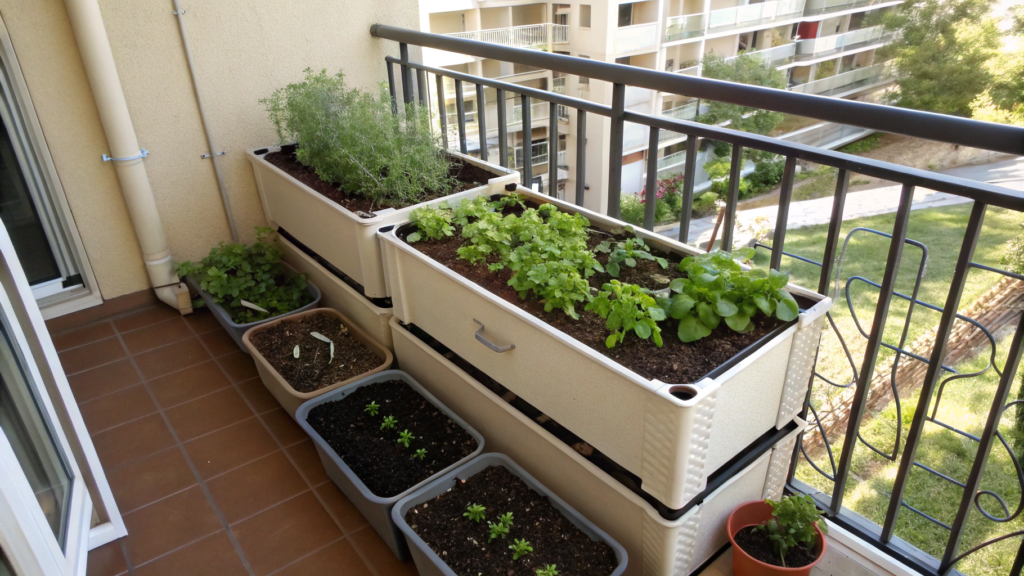
If you think a balcony is too small for gardening, you’re wrong. Even a tiny space can be turned into a garden if you use compact raised beds. They allow you to grow herbs, spicy herbs and even mini vegetables without cluttering up your balcony.
The Keter Easy Grow Raised Garden Bed is compact, self-watering and ideal for small balconies.
How do you create the perfect garden bed for your balcony?
Choose a sunny spot.
- Herbs and greens need 6+ hours of sun a day. If sunlight is not enough, you can use phytolamps.
Use lightweight soil.
- Regular garden soil won’t work – it’s too heavy and doesn’t retain moisture well. But a mixture of coconut substrate, compost and vermiculite reduces weight and retains moisture.
Drainage.
- At the bottom of the container you need to lay 5-7 cm of expanded clay, gravel or fine crushed stone to prevent stagnation of water.
Make several tiers.
- Vertical racks or tiered containers will help grow more in the same space.
Add self-watering.
- A built-in reservoir or drip irrigation will reduce the need for frequent maintenance.
What can you grow in a balcony bed?
- Greens – spinach, arugula, watercress, dill, parsley.
- Aromatic herbs – basil, mint, thyme, rosemary, thyme.
- Mini vegetables – dwarf tomatoes, hot peppers, mini eggplants.
- Berries – strawberries in hanging pots or small containers.
Tip. Plant basil next to tomatoes, it improves their flavor and protects them from pests.
13. Portable Container Raised Beds – Best for City Gardening!

City gardeners have to be creative, as not everyone has a fixed place for their beds. If you live in a rented apartment, move around a lot or just like to rearrange your plants, portable beds solve this problem. They can be easily carried, rearranged seasonally, and even brought into the house for the winter.
How do you use portable beds?
1. Flexible placement
- These beds can be placed on a balcony, terrace, roof, loggia or even just in the yard.
- In the fall or winter, they can easily be moved inside, providing the plants with comfortable conditions.
2. Variety of materials
- Fabric beds – breathable, retain moisture, do not overheat in the sun.
- Plastic containers – lightweight, comfortable, but may require drainage holes.
- Flexible polyethylene structures – durable but less aesthetically pleasing.
3. Choosing soil and drainage
- Light and nutritious soil made from coconut substrate, compost and garden soil.
- At the bottom of such beds it is better to lay expanded clay or agro-perlite – this will ensure the outflow of excess moisture.
- Mulching (wood chips, straw) will protect the roots from overheating and preserve moisture.
In portable beds you can grow herbs and herbs (dill, parsley, spinach, basil). Mini vegetables (dwarf tomatoes, sweet peppers, radishes), strawberries and low-growing flowers (nasturtium, velvet, marigold) take root well.
Tip. It is best to choose beds made of breathable fabric, as they retain moisture better and prevent the roots from overheating.
14. Raised Garden Beds with Built-In Storage – Maximize Efficiency!
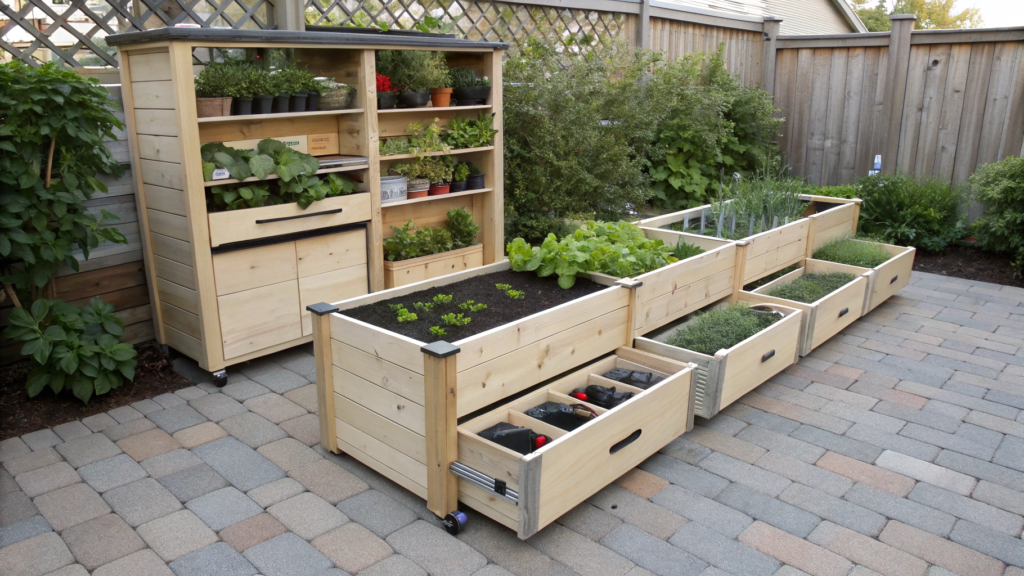
Garden beds with integrated storage systems are suitable for gardeners who want order and efficiency. They not only allow you to grow plants, but also conveniently store garden tools, fertilizers and other necessary materials right at your fingertips.
The benefits of such beds are:
- Space organization. Built-in shelves and drawers provide neat storage of tools and materials, which is especially important in small areas.
- Ergonomics. The optimal height of the bed allows you to work without bending over, reducing the load on your back and knees.
- Stable design. Additional elements such as shelves give the bed extra strength and stability.
Yaheetech Raised Garden Bed with Shelf – wooden bed with lower shelf for storing tools and materials.
What can be grown in these beds?
Vegetables: tomatoes, peppers, eggplants.
Greens: spinach, lettuce, parsley, basil.
Root vegetables: carrots, radishes, beets.
Tips for use:
- Drainage. Make sure drainage holes are provided in the bed to prevent water stagnation and root rot.
- Soil. Use good quality soil enriched with compost to provide plants with the nutrients they need.
- Mulching. Apply mulch to conserve moisture and suppress weed growth.
Built-in storage beds combine functionality and aesthetics to create an organized and productive garden space.
15. Mini Raised Beds for Kitchens – Fresh Herbs Always at Hand!
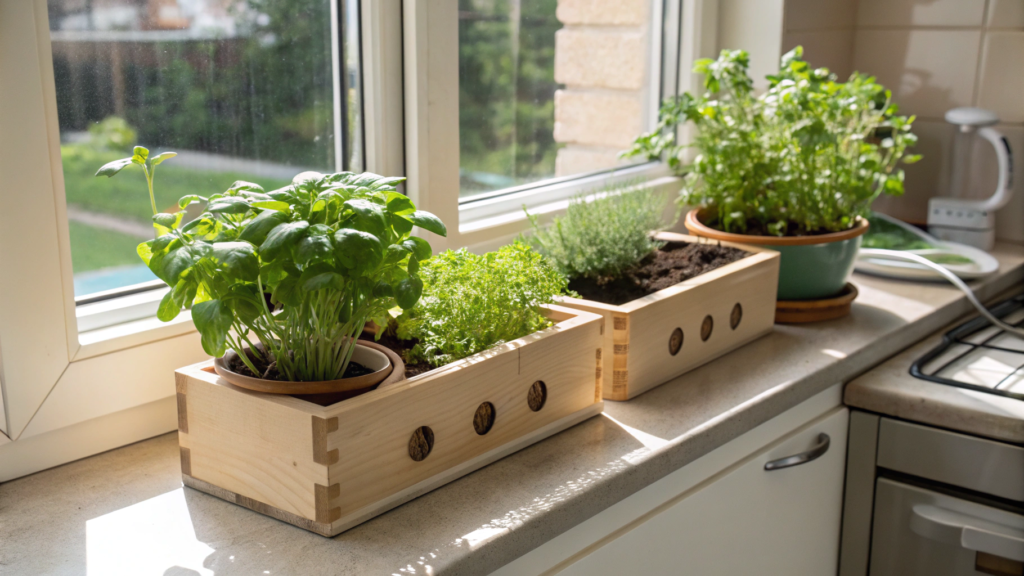
Imagine, flavorful herbs right in your kitchen, ready to go into your dishes. So mini beds are just the perfect solution for those who love natural flavors and want to add brightness and freshness to their culinary masterpieces.
How to organize a mini bed in the kitchen?
Choose the right place
- A windowsill or kitchen table next to a window – at least 4 hours of sunlight a day.
- If natural light is scarce, use an LED phytolamp.
Choose the right containers
- Compact pots, wooden mini beds or wall-mounted containers.
- Preferably, the container should have drainage holes to avoid stagnant water.
Use light soil
- The best option is a mixture of peat, coconut fiber and compost.
- Add vermiculite or sand for good drainage.
Water properly
- Don’t overwater! Most herbs don’t like soil that is too wet.
- Water as the top layer dries out (usually every 3-4 days).
What plants are suitable for the kitchen bed?
- Aromatic herbs – basil, thyme, rosemary, mint, sage, oregano.
- Greens – spinach, watercress, arugula, leaf lettuce.
- Mini vegetables – dwarf tomatoes, hot peppers, mini eggplants.
Tip. Don’t plant mint next to rosemary because mint likes moisture and rosemary likes dry soil.
Find your perfect bed
Now you have all the ideas and tools to create a bed on even the smallest plot. A balcony, a roof, a narrow strip along a fence or even a window sill can all be turned into a fruit-bearing garden.
The main thing is to choose the right option for your conditions and needs. Don’t be afraid to experiment, try, plant, care for – and even the smallest corner will bring harvest and joy!
Which raised garden bed will you choose? Let me know in the comments!
Happy gardening!
